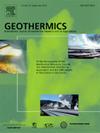A conceptual model and changing trends for the Yangbajing geothermal field in the Tibetan Plateau: New insights from hydrochemistry and multi-isotopes
IF 3.9
2区 工程技术
Q3 ENERGY & FUELS
引用次数: 0
Abstract
High-temperature geothermal resources have enormous potential for geothermal power generation, such as the first and largest geothermal power station of the Yangbajing geothermal field (YGF) in China. However, the understanding of geothermal genesis has yet to be improved, and changes in the geothermal system under long-term exploitation remain unclear, hampering the sustainable development of the YGF. Hence, this study conducted hydrochemical and multi-isotopic (D-O-Sr-Li-C) isotopic analyses to improve the genesis model of the YGF and to investigate the changes in the geothermal system compared with the samples from 1995 and 2006. The results show that the hydrochemical processes are mainly determined by the leaching of silicate minerals (albite and K-feldspar) and cation exchange. δD and δ18O indicate that the recharge source is primarily snowmelt water (5,221–5,788 m) from the Nyenchen Tonglha Mountains, mixed with the magmatic fluids (10–20 %). δ13C results suggest that the dissolved inorganic carbon (DIC) is derived from the thermal decomposition of deep marine carbonate rocks and magma degassing, and the corrected 14C ages show the residence time of geothermal waters is from 16,035 to 28,283 years. 87Sr/86Sr and δ7Li results identify that geothermal waters are formed by mixing between deep melt and shallow cold water, which are stored in a Pliocene granite reservoir. The comparisons with previous data show that the hydrochemical types of geothermal waters changed from Cl-Na in 1995 and 2006 to Cl·HCO3-Na and HCO3-Na in 2022. The hydrochemical differences are caused by the decreasing contribution (20–26 % to 10–20 %) of deep fluids and the increasing mixing (55 % to 68 %) of snowmelt water due to continuous exploitation and rising global temperatures over decades. Therefore, the reservoir temperatures declined from 274 °C to 189 °C from 1995 to 2022. The research achievements deepen the understanding of the geothermal genesis and clarify the changes of geothermal systems under long-term exploitation in the YGF, providing a scientific basis for the sustainable utilization of the high-temperature geothermal fields worldwide.
青藏高原羊八井地热田的概念模型及变化趋势:来自水化学和多同位素的新认识
高温地热资源具有巨大的地热发电潜力,如羊八井地热田(YGF)是中国第一个也是最大的地热发电站。然而,对地热成因的认识尚不完善,长期开发过程中地热系统的变化尚不清楚,阻碍了YGF的可持续发展。为此,本研究开展了水化学和多同位素(D-O-Sr-Li-C)同位素分析,以完善YGF的成因模式,并与1995年和2006年的样品进行了地热系统的对比研究。结果表明,水化学过程主要由硅酸盐矿物(钠长石和钾长石)的浸出和阳离子交换决定。δD和δ18O表明,补给源主要为念陈通哈山脉的融雪水(5221 ~ 5788 m),并混入岩浆流体(10 ~ 20%)。δ13C结果表明,溶解无机碳(DIC)来源于深部海相碳酸盐岩热分解和岩浆脱气,校正后的14C年龄表明,地热水的停留时间为16,035 ~ 28,283年。87Sr/86Sr和δ7Li测定结果表明,该区地热水是深层融水与浅层冷水混合形成的,储层为上新世花岗岩储层。与前人资料对比表明,地热水水化学类型由1995年和2006年的Cl- na转变为2022年的Cl·HCO3-Na和HCO3-Na。水化学差异是由深层流体的贡献减少(20 - 26%至10 - 20%)和融雪水的混合增加(55%至68%)造成的,这是由于几十年来持续开采和全球气温上升造成的。因此,1995年至2022年,储层温度从274°C下降到189°C。研究成果加深了对地热成因的认识,阐明了YGF长期开发过程中地热系统的变化,为全球高温地热田的可持续利用提供了科学依据。
本文章由计算机程序翻译,如有差异,请以英文原文为准。
求助全文
约1分钟内获得全文
求助全文
来源期刊

Geothermics
工程技术-地球科学综合
CiteScore
7.70
自引率
15.40%
发文量
237
审稿时长
4.5 months
期刊介绍:
Geothermics is an international journal devoted to the research and development of geothermal energy. The International Board of Editors of Geothermics, which comprises specialists in the various aspects of geothermal resources, exploration and development, guarantees the balanced, comprehensive view of scientific and technological developments in this promising energy field.
It promulgates the state of the art and science of geothermal energy, its exploration and exploitation through a regular exchange of information from all parts of the world. The journal publishes articles dealing with the theory, exploration techniques and all aspects of the utilization of geothermal resources. Geothermics serves as the scientific house, or exchange medium, through which the growing community of geothermal specialists can provide and receive information.
 求助内容:
求助内容: 应助结果提醒方式:
应助结果提醒方式:


